Stormtrooper "Hs 129"
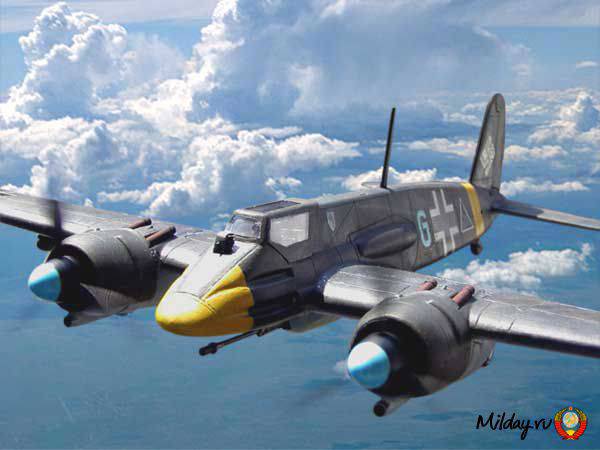
Analyzing Usage aviation in the battles of the first months of the Spanish Civil War, the German Ministry of Aviation concluded that it was advisable to develop a special armored fire support aircraft. This machine was supposed to fight with armored vehicles and literally crack the enemy’s defense line, which is why it received the unofficial name of “winged can opener”.
The development of the ground attack aircraft began in the autumn of 1937, when the Luftwaffe leadership made technical requirements for it. The aircraft was planned single, primarily because of the weight savings required to ensure the booking of the cabin. The refusal of the rear gunner was also explained by the fact that the attack aircraft was supposed to “work” under cover of fighters. Engine, according to experts, required at least two, so that in case of damage to one of them, the car could return to the base. As the main armament planned two 20-mm guns.
Four German aviation firms decided to take part in the project: Gotha (this concern was soon withdrawn from the competition), Hamburg aircraft factory (later renamed Blom and Voss), Focke-Wulf and Henschel. Despite the strict conditions, each company had its own views on the attack aircraft. The most unusual was the project R.40 of the Hamburg Aviation Plant, made according to an asymmetric aerodynamic configuration, with a gondola cabin located to the right of the engine. However, this innovative solution did not gain understanding from the military, although in the future, Blom and Foss was able to release a small series of reconnaissance aircraft BV 141, having a similar scheme. The designers of the Focke-Wulf designed a two-seater machine based on the Fw 189 two-gang scout project (the famous frame).
Most accurately meet the technical requirements of the development of Frederick Nikolaus, the chief designer of "Henschel." This project was a classic single-seat monoplane with a pair of inverted V-shaped Argus engines and a reserved cockpit. The fuselage section was triangular, to provide a more convenient arrangement of armor sheets. The pilot was located at the top of this triangle, so the cabin was very close, the pilot actually rested his shoulders against its walls.
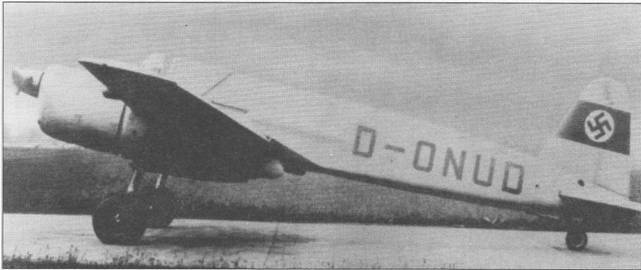
The review of the Focke-Wulf and Henschel projects took place in the spring of 1938. Due to the fact that the chief designer of the Focke-Wulf Kurt Tank decided to convert the first prototype of the Fw 189V1 into an attack aircraft, only after conducting its tests in the original reconnaissance version, the Henschel machine was the main focus. The task for the construction of the prototype was not immediately issued, especially since there were enough questions and complaints about the submitted project.
First of all, they noted a very tight cabin. However, in order to eliminate this drawback, a completely different cabin booking was required, and this led to a complete overhaul of the aircraft. In the end, we decided to leave everything as it is, finding that the pilot could suffer, since the duration of the attack aircraft flight was short.
In September 1938, the Ministry of Aviation ordered three prototypes, designated Hs 129, at the same time starting the preparation of equipment for mass production. The first Hs 129V1 was prepared in April 1939 of the year, and after a month and a half Hs 129V2 and V3 came out. Empty cars became heavier on 12%, moreover, they installed Argus engines on 410 As 0A-430. s., instead of those provided by 465 hp Because of this, even without armament and with incomplete refueling, the aircraft did not reach the promised characteristics. The attack aircraft turned out to be inert, and due to the large efforts on the controls, it turned out to be practically uncontrollable at dive angles more than 45 °. Because of this, the Hs 129V1 crashed during flight tests.
This state of affairs was clearly unacceptable, and the company urgently made improvements. On the Hs 129V4, which became the ancestor of the Hs 129-0 series, first of all, they put the engines As 410-1 with the promised power in 465 hp, and electric trimmers on the elevators and directions.
Flight tests of the first aircraft were carried out at Rechlin by both factory and military pilots. Their opinion was unanimous. The plane was very difficult to manage, especially near the ground in a turbulent atmosphere. To continue flying on one engine, the heavy machine practically could not. In addition to the cramped cabin, a lot of complaints caused the insufficient glazing of the lantern, therefore, because of poor visibility, management was even more complicated. Changing the shape of the flashlight and increasing the area of the glazing, they somehow coped with this problem, although the thick 75-mm bulletproof glass located almost at the very face of the pilot still impaired visibility. Because of the close cockpit, the control stick was made short and with a small power reserve, which required a lot of effort from the pilot when maneuvering. In the cramped cabin there was not enough space for all the devices, and the engine control indicators were located on the nacelles, so it was extremely inconvenient to monitor their readings.
Such an abundance of flaws, it seemed, should definitely lead to a halt to work on the Hs 129, but the double Fw 189V1b turned out to be even heavier and larger. Equipped with the same engines and similar cabin armor, the Fw 189V1b showed inferior flight performance, differing, however, by slightly easier handling.
The Focke-Wulf company subsequently released an improved version of the Fw 189V6 attack aircraft (not passing into the series), which was evaluated in the 2 squadron of the second training aviation squadron organized in the summer of 1940 of the year for the operational tests of the first Hs 129A-0.
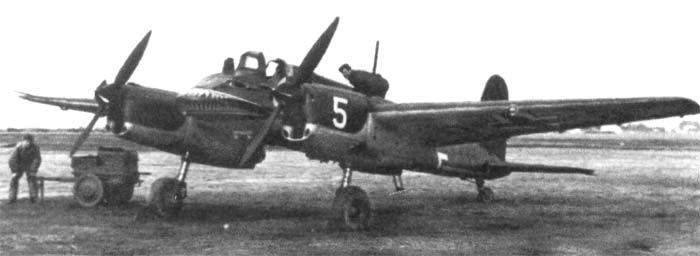
The cabin of the Hs 129, protected by thick sheets of armor, allowed the pilots to joke that the plane was made in the style of a steam locomotive, hinting at the popularity of the Henschel company with its locomotives. Four 12-mm slabs formed the front of the cab, the floor had the same thickness, and the side armor was made of steel in 6 mm. The pilot was sitting in a chair with armor and headrest. The design of the fuselage was all-metal, and the center section was connected to the wing and armor with bolts. The Argus As 410A-1 engines had 5-mm armor on the sides of the engine nacelle. The fuel was located in one tank in the 200 l, located just behind the cabin, and in two wing tanks of the 205 l. All small arms were in the nose and consisted of a pair of 7,9-mm MG 17 machine guns and two MG FF 20-mm aircraft guns. There was no space left for the ReviС 12 / С sight in the cab, and it was mounted outside in front of the windshield on the right.
The operational tests of the attack aircraft, which took place in the summer of the 1940 of the year, received such criticism from the command of the Luftwaffe that they considered the car unsuitable for adoption. The Hs 129А-0 aircraft turned out to be capable of taking only two 50-kg bombs on the outer suspension nodes. With such a load, the maximum dive angle was no more than 15 °. In the case of a high angle dive, the forces on the handle increased so much that the car became virtually unmanageable. Not close to criticism and cramped cabin with glazing, distorting the appearance, which was the cause of a number of different flight accidents.
Even during the testing period, the developers of Henschel created the Hs 129A-1 version with a new cab (having a better overview) and easier control. Despite this, the Luftwaffe refused to accept the first seven copies of the Hs 129A-1, deciding to cease production of the unsuccessful aircraft.
The main source of trouble for the Hs 129 from the very beginning was considered a weak engine. In addition to the "Argus", German industry at that time did not have a suitable engine. After the capitulation of France in the summer of 1940, the opportunity arose to use the French air-cooled engine. "Gnome-Ron" 14M was heavier than the "Argus" almost twice, but at the same time it was more powerful by 50%. The designers began to urgently work out the variants of the attack aircraft for new engines to resume the serial production of the attack aircraft. Worked on two main options: the first was a modified Hs 129 with an extended fuselage, the second - increased in all sizes. But these modifications did not suit the leadership of the Ministry of Aviation, primarily because they demanded the replacement of all the serial equipment on which the first Hs 129 were produced.
At the beginning of 1941, two Hs 129A-0 decided to mount 700-strong "Gnome-Ron" 14М 4 / 5 and carry out the required modifications without transforming the basic design. The wings were somewhat reinforced for mounting heavier engines and repackaged the equipment to maintain the necessary centering. At the same time, a series of 10 copies was laid, designated Hs 129В-0.
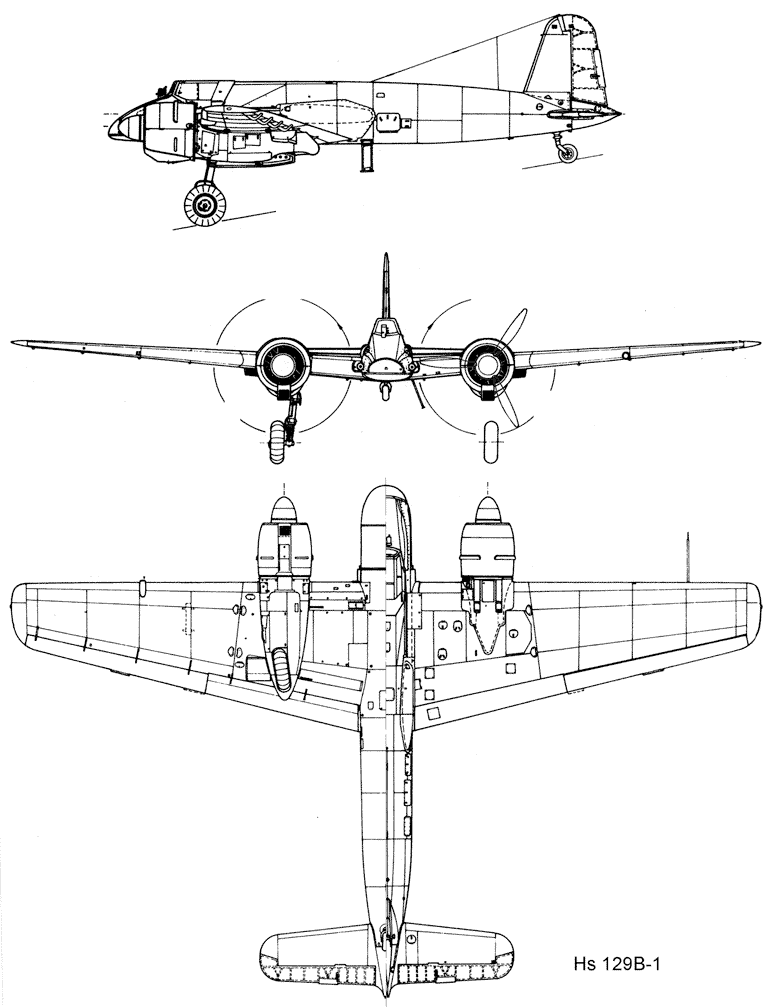
Tests Hs 129B-0 conducted in Rechlin revealed that hope was vain and special changes in the behavior of the machine was not observed. However, the series has already been deployed, and the armored attack aircraft was in great demand in the war that had flared up, production should not be stopped. The first to receive a new aircraft training aviation unit.
The next modification was the Hs 129В-1, on which two MG 17 machine guns were left in the nose, and a couple of MG FF guns on the new machine changed the MG 151 of equal caliber, but with higher characteristics. Also installed outdoor units for the suspension of interchangeable weapons. The R-1 suspension consisted of two 50-kg bombs or two 48 cassettes with anti-personnel SD 2 bombs each. The R-2 version was equipped with an 30-mm MK 101 gun with 30 ammunition shells in a special fairing. In the R-3 version, a four-battery battery was suspended. Suspension R-4 - from one 250-kg bomb or four, or 96 bombs SD 2, a R-5 included the installation of the camera.
The first Hs 129B-1 was sent to the 4 th squadron of the 1 th assault air squadron, located in north-west Germany. In the spring of 1942, all 12 squadron airplanes flew to the Eastern Front. The combat work of attack aircraft from dusty steppe airfields proved to be an ordeal for French engines, which were already not particularly distinguished by special reliability. When flying in Europe from concrete lanes, engine carburetors practically did not clog, and in the field conditions of the eastern front weak air filters could not cope with mobile dust. As a result, the squadron was not combat-ready for almost half a year, standing idle while waiting for new filter elements.
Even more disappointing was the use of the new Henschels in North Africa. The 4 Squadron of the 2 th Assault Aviation Squadron was formed at the end of the summer of 1942 in Poland, and on November 30 12 Hs 129B-1 went to the north of Africa to help Rommel. At the same time during the flight to Libya, the squadron lost four aircraft due to the failure of unreliable engines. For the remaining attack aircraft, African sand was no better than Russian dust. New filters helped a little, and two more airplanes crashed in enemy territory due to clogged carburetors. The remaining Hs 129 were transferred to Tripoli, but the advance of the English army forced the evacuation of the remnants of the unit to Bari (Italy).
Despite the military setbacks, the plant in Schönefeld continued the serial production of the Hs 129B-1. Perhaps the only advantage of the Hs 129, compared with the more maneuverable, but worse armed Ju 87, performed similar tasks, was the presence of an armored cabin, reliably protecting the pilot from ground fire. But the poor performance and poor engine protection all crossed out. In case of failure or damage of one of the engines, the pilot could come back, just dropping all the outboard weapons, and still it was necessary to be able to keep the naughty car. Only the absence of a more suitable aircraft to combat armored vehicles, especially with the Soviet T-34 and KB, forced the Luftwaffe to leave the Hs 129 in service. Although new modifications of the Yunkers Ju 87D-5 with 20-mm guns and Ju 87G with two 37 mm caliber guns appeared, they practically had no armor and also had a lower speed due to the non-retractable chassis.
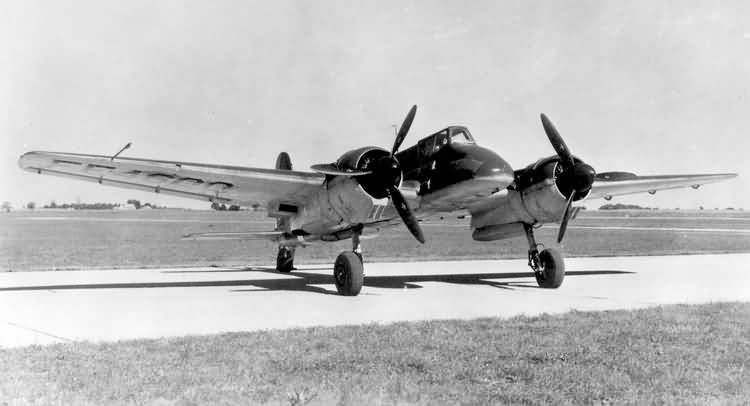
At the beginning of 1943, special units of fighter planes were created on the Eastern Front tanks. The first such squadron was the separate 51st fighter aviation squadron, armed with a Hs 129B-1 / R-2 with a 30-mm MK 101 gun. But already the first meetings with our T-34 and KB revealed that the frontal armor of our tanks was not attack aircraft makes its way. Then the Nazis began to use cumulative bombs weighing 4 kg each. To increase the likelihood of hitting the target, three attack aircraft dived one after another in a single line, simultaneously bombing. Theoretically, this is correct, but in practice this method turned out to be difficult due to the limited visibility of the pilot from the cramped cockpit.
The next on the Eastern Front was the 8 Squadron, along with the newly completed 4 Squadron of the 2 Squadron, which so badly began its combat career in North Africa. Four squadrons had the opportunity to participate in Operation Citadel, which began in the summer of 1943 at the Kursk Bulge. The task of the attack aircraft was the same - Soviet tanks, and the flights of aircraft made almost without interruption. At a time when one squadron's Henschel was attacking tanks, another squadron was preparing for departure, the third was taking off, and the fourth was returning to the airfield. Such an active use of German attack aircraft could cause a lot of trouble to the Soviet tank crews, although without a reliable fighter cover, Henschel turned out to be defenseless against the attacks of our aircraft and suffered significant losses.
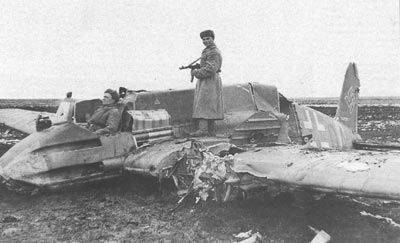
In the autumn of 1943, all the squadrons of the Hs 129 on the Eastern Front were brought together into the 4 th tank group of the 9 th assault aviation squadron. Along with the German pilots, the pilots of the Royal Romanian Air Force took part in the fighting at the Henschel. It should be said that at the same time with the 62 Hs 129B, the Germans transferred to the allies seven old Hs 129А-1 with Argus engines removed from service with the Luftwaffe as early as 1940.
Replacing a pair of MG 17 machine guns on large-caliber MG 131, got the option Hs 129B-2. Similar to the previous modification, it was possible to hang on it various versions of weapons, using external nodes. Since the main task of "Henschel" was the fight against tanks, it was wisely decided that it would be much more convenient to equip an attack aircraft with a built-in anti-tank weapon right at the factory. This idea led to the emergence of Hs 129B-2 / Wa ("waffeptrager" - carrier weapons). The new version is equipped with 30-mm cannon MK 103 with a high initial velocity of the projectile. Separate copies had 37-mm gun VK 37, but for this it was necessary to dismantle both course MG 131 machine guns. However, there was little confusion. The German "flying can opener" was powerless in front of the armor of our tanks.
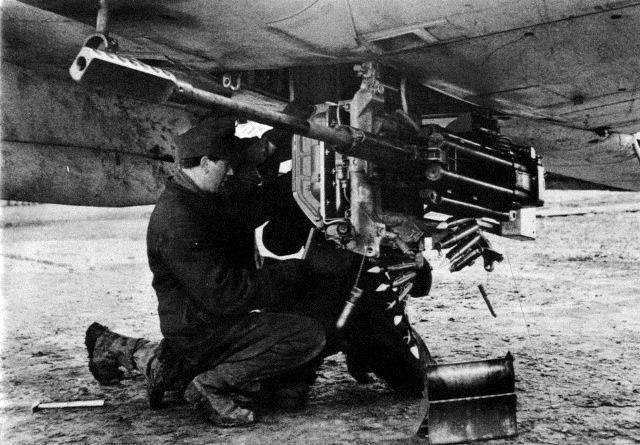
German designers have not ceased to puzzle over what to come up with for a successful fight against the invulnerable T-34 and HF. At the beginning of 1944, a special 26 test team was organized at Udetfeld, in Germany, to test new weapons. Detachment experienced a diverse range of weapons: missiles Wfr.Gr.21 (210mm) and Wfr.Gr.28 (280mm) 70mm missile "Pantserblitts 1" and 50mm "Pantserblitts 2", aviation mortar and even SG 113A 300 liter incendiary tanks. However, all these weapons turned out to be ineffective, or unfinished.
The most optimal, it seemed, was the proposal to use the RaK40 anti-tank gun of the 75 mm caliber. However, aerodynamics were worried about the presence of a large fairing for the gun mounted below. Tests in Travemünde in May 1944 showed that it is generally possible to fly in this configuration. Having replaced the mechanical drive with an electric one, and having mounted a powerful muzzle brake, the cannon that received the VK 7,5 cipher equipped a small series Hs 129B-3 / Wa.
The final and most powerful attack aircraft received two squadrons on the Eastern Front in service on the eve of 1945. Heavy (weighing 12 kg) 75-mm cannon shells were a serious weapon against any armored vehicles, but the Hs 129В-3 / Wa attack aircraft produced a little, and the complete superiority of our aircraft in the sky did not allow the German machines to carry out their attacks with impunity.
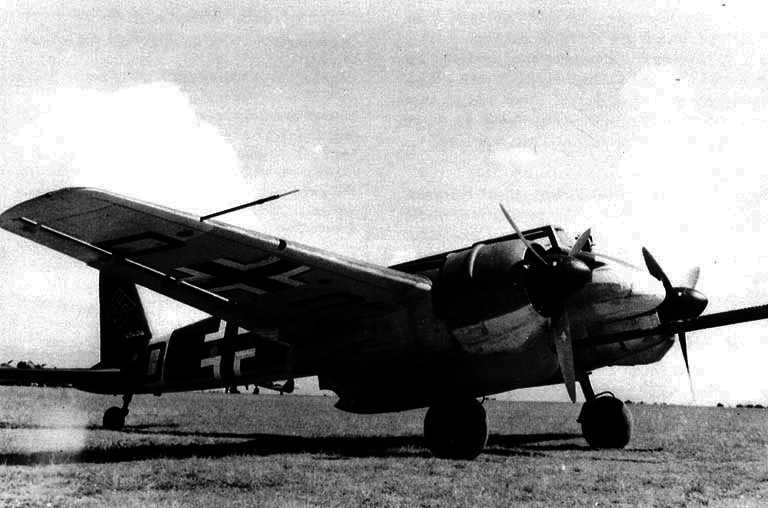
Paradoxically, Henschel "had to make war against Germany. Romania, capitulation 23 August 1944, declared war on its recent ally. And 21 September 24 Hs 129 Romanian air forces together with the Soviet troops attacked the positions of Hitler's troops.
At Luftwaffe at the end of 1944, only two squadrons of Hs 129, which were on the Eastern Front, made sorties. Other compounds suffered heavy losses and were disbanded.
Serial production of ground attack aircraft was stopped in September 1944, when the aviation ministry demanded that only fighter jets leave. Total collected 859 Hs 129 various modifications. The Henschel Design Bureau tried even earlier to produce a version of the aircraft with two Izotta-Frascini Delta RC engines 16 / 48 using 840 hp. and armed with two guns MK 103 caliber 30 mm. But because of the failure of the engines, not one Hs 129C was built.
The use of Hs 129 on the fronts could not have a significant impact on the course of hostilities, in contrast to the use of the Soviet attack aircraft Il-2. And the reason is not a small series of aircraft, but above all its flaws: heavy control, low speed, unreliability and poor booking of engines, the lack of protective weapons behind. The Luftwaffe pilots were more than skeptical about their Henschels. One of the German pilots after the war admitted that the characteristics of the car were so bad and the flights were so dangerous that he was still tormented by nightmares. And the same pilot called the container with accessories in case of an emergency landing the most reliable unit Hs 129. And in this compartment, located in the center of the right wing, were a pistol, a helmet, and a gas mask.
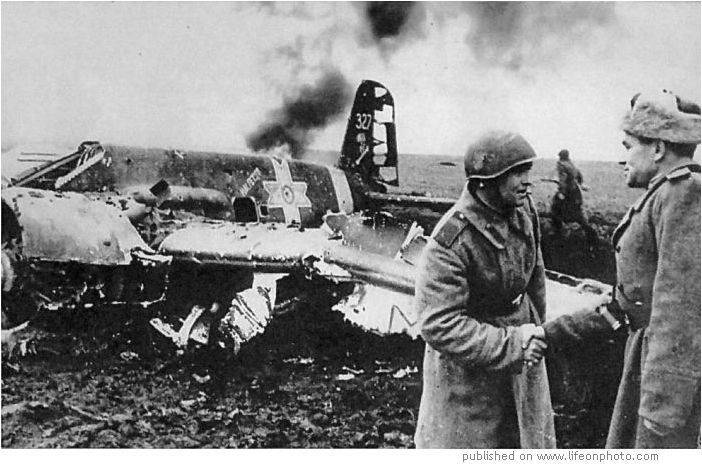
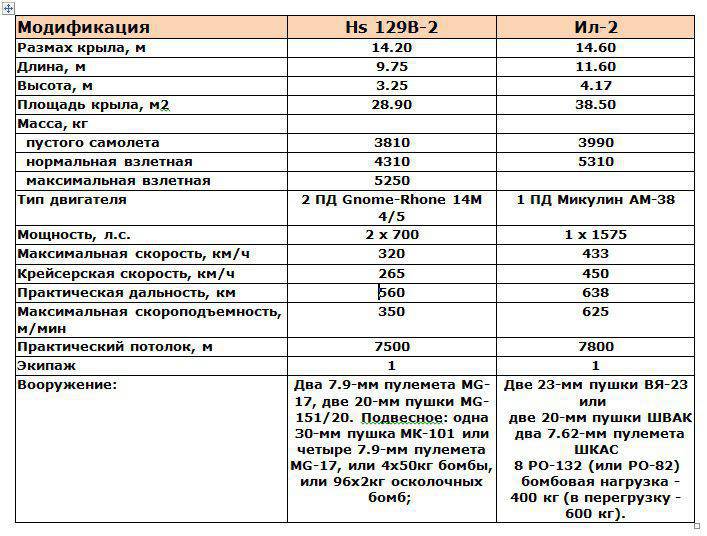
Sources:
Kondratyev V. "The Flying Locomotive" of the firm "Henschel" // Aviamaster. 2000. No.6. C. 21-27.
Ivanov S. Hs 129 - fighter of Soviet tanks // War in the air. No.17. C.3-7, 26-30.
Kolov S. Characteristics are bad, flights are dangerous // Wings of the Motherland. 1999. No.2. C. 28-31.
Green William. Wings of the Luftwaffe (warplanes of the Third Reich). CH 4. M .: Publishing Department TsAGI, 1995. C. 277-280.
Obukhov V., Kulbaka S., Sidorenko S. Planes of the Second World War. Minsk: Potpourri, 2003. C.228-230.
Information